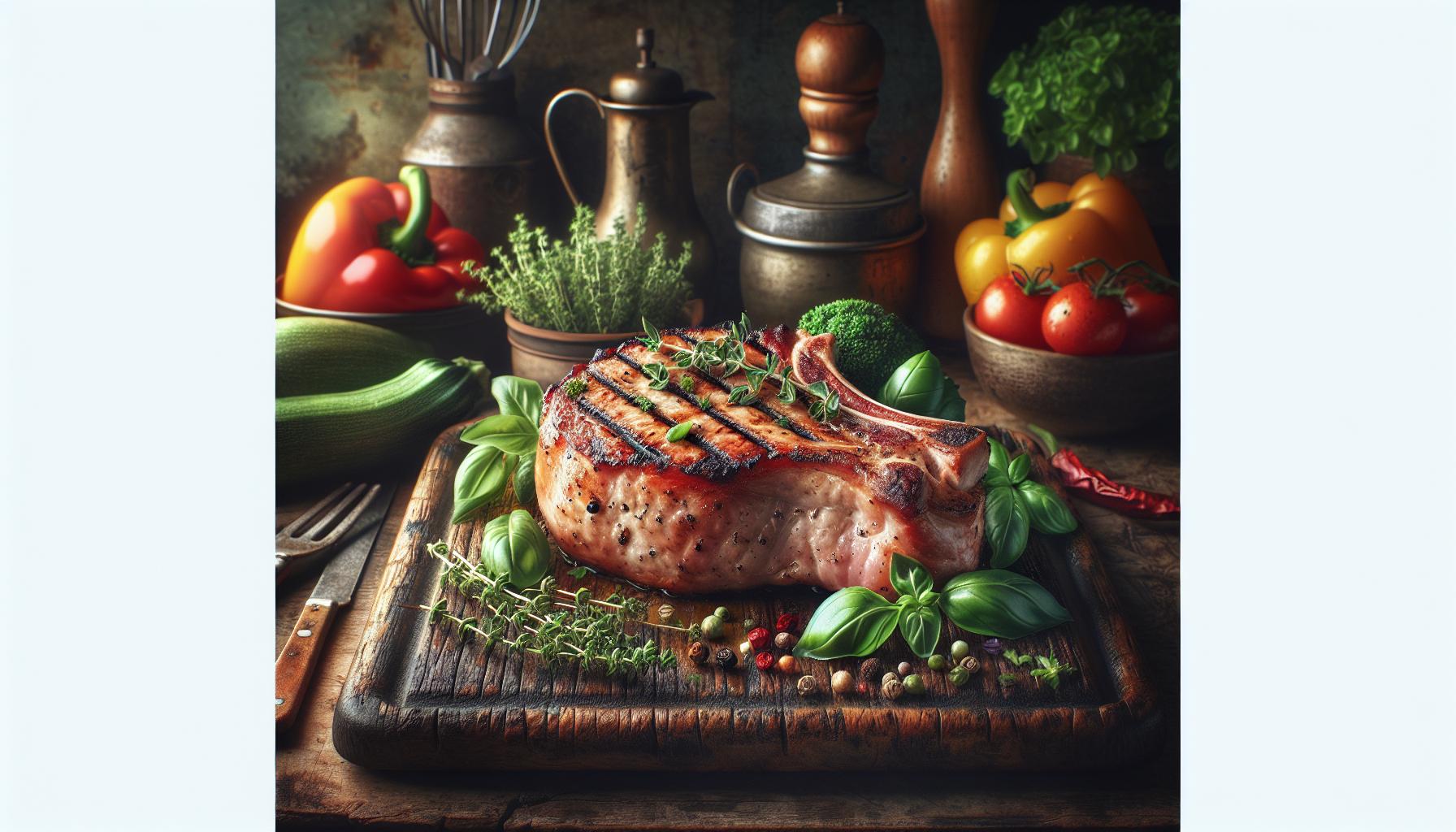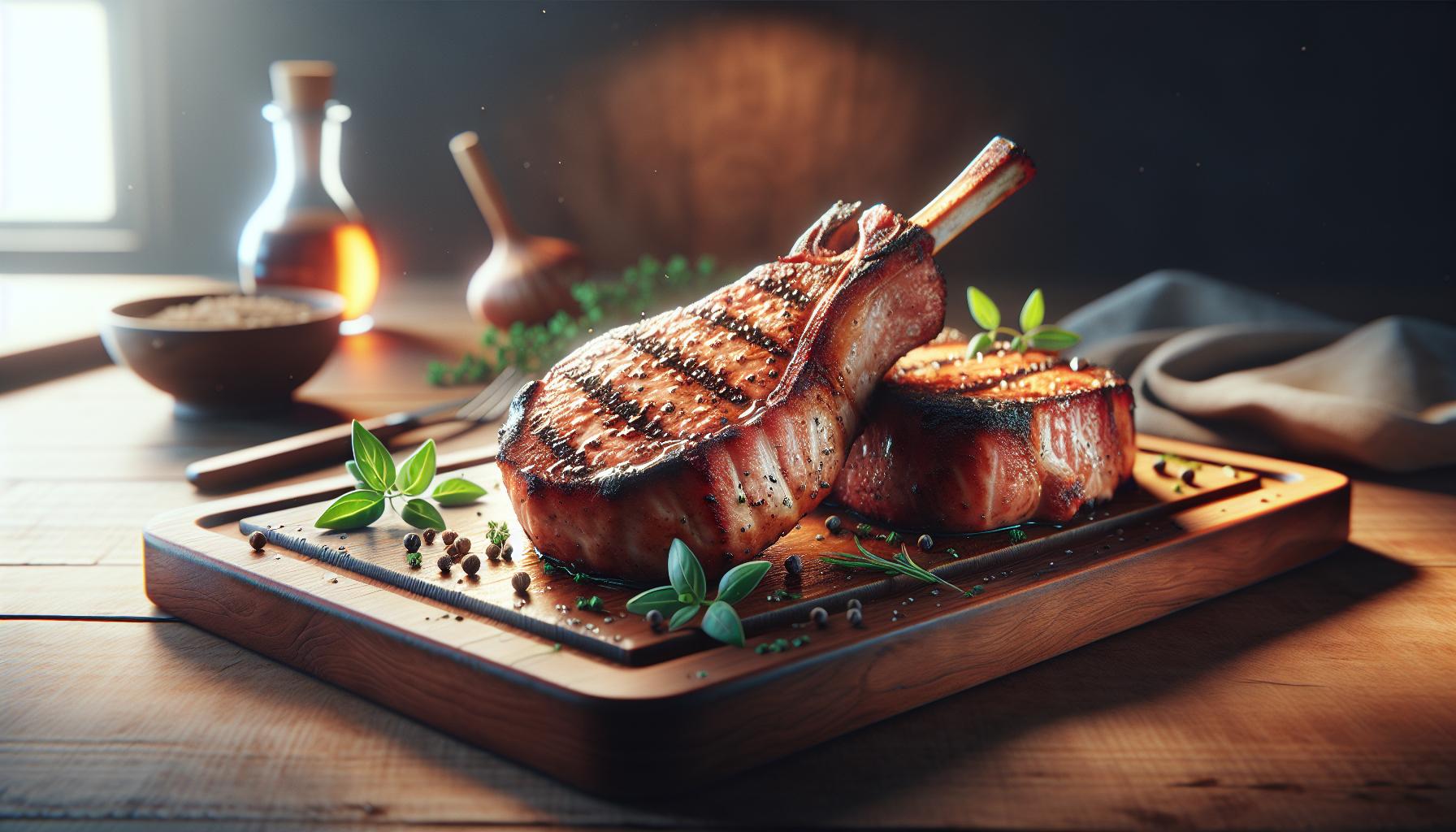Looking for a protein-packed meal that won’t break your calorie bank? Boneless pork chops might just be your new best friend in the kitchen. These lean cuts of meat pack a serious nutritional punch while keeping things light and delicious.
At roughly 120 calories per 3-ounce serving, boneless pork chops have transformed from the fatty comfort food of yesteryear into a modern health-conscious choice. They’re not just about protein anymore – these versatile cuts deliver essential nutrients like zinc, phosphorus and B-vitamins that support everything from immune function to energy metabolism. Whether you’re tracking macros or simply trying to eat healthier without sacrificing flavor, understanding pork chop nutrition can help you make smarter choices at the dinner table.
Boneless Pork Chop Nutrition
Boneless pork chops are lean cuts of meat taken from the loin section of the pig with the bone removed. These versatile cuts offer a protein-rich option that’s easier to prepare than their bone-in counterparts.
Different Cuts and Selection Tips
Boneless pork chops come in three main varieties: center cut, top loin chops, and sirloin chops. The center cut ranks as the most premium choice, featuring a uniform shape and consistent marbling. Top loin chops contain more fat marbling, creating a juicier texture when cooked. Sirloin chops offer a leaner option with less fat content.
Key selection indicators include:
- Color appears pinkish-red without gray spots
- Texture feels firm to the touch
- Marbling shows thin white streaks throughout
- Thickness measures 1 to 1.5 inches for optimal cooking
- Package contains no excess liquid or pooling
| Characteristic | Premium Quality | Standard Quality |
|---|---|---|
| Fat Content | 2-4% | 5-8% |
| Color | Bright pink | Pale pink |
| Moisture | Minimal | Some moisture |
| Texture | Very firm | Slightly soft |
Nutritional Profile of Boneless Pork Chops

Boneless pork chops pack essential nutrients in a lean protein package. The nutritional composition varies based on the specific cut with center-cut chops offering the most balanced profile.
Protein and Amino Acid Content
A 3-ounce serving of boneless pork chops contains 23 grams of complete protein. This protein composition includes all nine essential amino acids the body requires for muscle maintenance growth repair. The amino acid breakdown includes 2.1g leucine 1.8g lysine 0.9g methionine per serving. These proteins support:
- Muscle tissue repair after exercise
- Enzyme production for metabolism
- Immune system function
- Hormone synthesis
- Collagen formation for skin health
Fat and Calorie Breakdown
A 3-ounce portion of trimmed boneless pork chops provides:
| Nutrient | Amount |
|---|---|
| Calories | 120 |
| Total Fat | 3.5g |
| Saturated Fat | 1.2g |
| Monounsaturated Fat | 1.5g |
| Polyunsaturated Fat | 0.4g |
| Cholesterol | 65mg |
The fat content remains relatively low compared to other meat options making pork chops suitable for calorie-conscious diets.
Vitamins and Minerals
Boneless pork chops deliver essential micronutrients in significant amounts:
| Nutrient | % Daily Value |
|---|---|
| Zinc | 14% |
| Phosphorus | 20% |
| Selenium | 45% |
| Vitamin B6 | 15% |
| Vitamin B12 | 8% |
| Niacin | 25% |
| Thiamin | 18% |
These minerals support immune function energy production bone health. The B-vitamin complex aids metabolism cellular repair nerve function.
Health Benefits of Eating Pork Chops

Boneless pork chops deliver essential nutrients that support multiple bodily functions. These lean cuts promote overall health through their rich protein content combined with vital minerals.
Muscle Growth and Recovery
Boneless pork chops contain 23 grams of complete protein per 3-ounce serving, supporting optimal muscle development. The high-quality protein includes branched-chain amino acids (BCAAs) leucine, isoleucine, valine which stimulate muscle protein synthesis. These amino acids activate mTOR pathways responsible for muscle growth signaling in the body. The zinc content in pork chops aids protein synthesis regulation enhancing post-exercise recovery. Studies show consuming adequate protein from sources like pork chops increases muscle mass gains during resistance training programs.
Blood Cell Formation
The iron content in boneless pork chops supports red blood cell production maintaining healthy hemoglobin levels. Vitamin B12 found in pork chops plays a crucial role in DNA synthesis for new blood cell formation. The combination of iron vitamin B12 helps prevent anemia by ensuring proper oxygen transport throughout the body. Selenium present in pork chops supports thyroid function which regulates red blood cell metabolism. Research indicates consuming iron-rich meats like pork chops improves blood markers in individuals with iron deficiency.
Cooking Methods That Preserve Nutrients

Proper cooking techniques maintain the nutritional value of boneless pork chops while ensuring food safety. The right preparation methods lock in essential nutrients such as protein, B-vitamins, and minerals.
- Trim visible fat before cooking to reduce overall calorie content
- Marinate pork chops in citrus juices or vinegar-based marinades for 30 minutes to tenderize the meat
- Pat chops dry with paper towels before cooking to achieve better browning
- Heat cooking surface to 375°F (190°C) before adding pork chops
- Cook until internal temperature reaches 145°F (63°C), followed by 3 minutes rest
| Cooking Method | Nutrient Retention | Cooking Time (1-inch thick) |
|---|---|---|
| Grilling | 85-90% | 8-10 minutes |
| Broiling | 80-85% | 10-12 minutes |
| Pan-searing | 75-80% | 4-5 minutes per side |
| Baking | 70-75% | 20-25 minutes |
- Using minimal oil (1 tablespoon per 2 chops)
- Avoiding excessive breading or coating
- Seasoning with herbs spices (rosemary, thyme, garlic powder)
- Limiting added salt to ¼ teaspoon per chop
- Pairing with steamed vegetables or whole grains
Portion Size and Dietary Recommendations
A standard serving of boneless pork chops equals 3 ounces (85 grams) cooked weight. Adult dietary guidelines suggest consuming 5 to 6.5 ounces of lean protein daily, making pork chops suitable for meeting these requirements.
| Portion Type | Weight | Daily Value % (based on 2000 cal diet) |
|---|---|---|
| Small | 3 oz (85g) | 25% protein |
| Medium | 4 oz (113g) | 33% protein |
| Large | 6 oz (170g) | 50% protein |
Recommended serving frequencies vary based on individual health goals:
- Athletes consume 4 to 6 ounces per meal for muscle recovery
- Weight management plans include 3 to 4 ounces per serving
- Heart healthy diets limit portions to 3 ounces twice weekly
Dietary considerations affect portion sizes:
- Active adults benefit from 4 to 5 ounces per serving
- Seniors require 3 ounces to maintain muscle mass
- Children ages 4-8 consume 2 to 3 ounces per serving
Meal planning guidelines for boneless pork chops:
- Pair with 2 cups of vegetables
- Add 1 cup of whole grains
- Include 1 tablespoon of healthy fats
- Limit sodium intake to 140mg per serving
- Refrigerate raw chops 3 to 5 days
- Freeze portions up to 6 months
- Store cooked chops 4 days maximum
- Package individual portions for convenience
Integrating Pork Chops Into a Balanced Diet
Boneless pork chops fit seamlessly into various meal plans as a lean protein option. Creating balanced meals involves pairing 3 ounces of pork chops with complex carbohydrates vegetables.
Optimal meal combinations include:
- Grilled pork chops with quinoa salad greens
- Pan seared pork chops alongside roasted sweet potatoes broccoli
- Baked pork chops served with brown rice steamed carrots
Portion control plays a key role in meal planning:
- Breakfast: 3 oz pork chop with egg whites oatmeal
- Lunch: 4 oz pork chop on mixed greens
- Dinner: 3 oz pork chop with vegetable stir fry
Macro distribution for a balanced pork chop meal:
| Nutrient | Amount per Meal |
|---|---|
| Protein | 25-30g |
| Carbohydrates | 30-45g |
| Healthy Fats | 10-15g |
| Total Calories | 350-450 |
Timing considerations enhance nutritional benefits:
- Post workout meals benefit from lean protein content
- Lunch portions provide sustained energy throughout afternoon
- Evening meals focus on smaller portions with more vegetables
Strategic meal prep options maximize convenience:
- Batch cook pork chops for multiple meals
- Slice cooked portions for salad toppings
- Package individual servings with precut vegetables
- Store prepared meals in portioned containers
- Gluten free preparations without breading
- Low carb pairings with leafy greens
- Dairy free seasoning options
- Mediterranean style olive oil based marinades
Boneless pork chops stand out as a versatile and nutritious protein choice for health-conscious individuals. Their impressive nutrient profile includes essential vitamins minerals and high-quality protein while maintaining a relatively low calorie count. The lean nature of these cuts combined with proper cooking techniques makes them an excellent option for various dietary needs.
Whether someone’s focusing on muscle building weight management or overall health boneless pork chops fit seamlessly into a balanced meal plan. With the right preparation methods and portion control these lean cuts can help achieve nutritional goals while delivering satisfying and flavorful meals.

